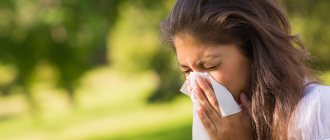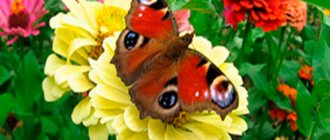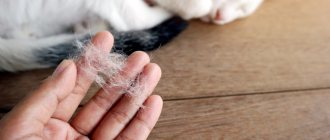Flower allergy is a condition that significantly reduces the quality of life. More often it develops in the spring and is accompanied by lacrimation, nasal congestion and cough. The symptoms are very similar to a cold, which is why going to the doctor is delayed.
Allergies cannot be ignored. This can lead to serious and very dangerous consequences. As well as self-prescribed treatment. Therapy should be prescribed only by an allergist, and he should also be consulted about traditional medicine recipes.
Symptoms of spring flower allergy
In central Russia, there are three stages of flower allergies.
The first sign is a slight tingling in the nose, as if particles from the atmosphere had entered there.
At the height of flowering, the following manifestations can be detected:
- Itching in the nose, ears, throat, eyes;
- The appearance of a profuse runny nose;
- Incessant sneezing;
- Nasal congestion;
- Redness of the eyes;
- lacrimation;
- Swelling of the nose and eyes;
- The occurrence of headache due to the onset of symptoms;
- A dry cough is often present;
- Difficulty breathing is the most unpleasant symptom when it is impossible to inhale and exhale normally, which prevents you from performing any activity normally;
- Development of skin itching, urticaria.
In addition to the symptoms, general malaise, weakness and increased fatigue may be added.
The disease is dangerous because it can lead to the development of bronchial asthma. The allergy can spread to other types of plants, thereby tormenting from spring until autumn.
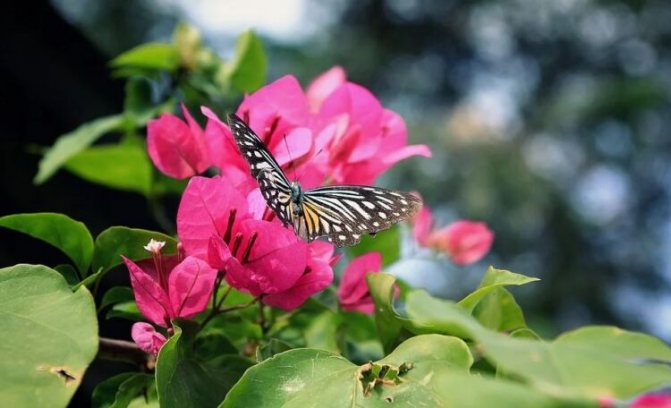
It is important to eliminate the disease in a timely manner using various treatment methods.
Corticosteroids for treating allergies
Corticosteroid drugs (cortisone, hydrocortisone, dexamethasone, betamethasone) have the most powerful effect on relieving allergy symptoms. This is explained by the fact that they affect all biological mechanisms that are responsible for the occurrence of an allergic reaction. They prevent the release of histamine and other factors necessary for an allergic reaction into the blood; prevent inflammation and allergic transformation of connective tissue; reduce antibody production; suppress inflammatory processes.
There is one characteristic feature in the use of corticosteroid drugs: these drugs are not suitable for long-term use, since they have not only a powerful anti-allergic effect, but also equally powerful side effects. For this reason, they are usually prescribed for a period of no more than 5 days to relieve acute allergy symptoms. further treatment is carried out with other drugs with less pronounced side effects.
In cases where long-term therapy with corticosteroid drugs is necessary, concomitant medications and dietary supplements are prescribed to maintain the functioning of the adrenal cortex.
What plants and pollens can you be allergic to?
The disease occurs on different types of plants and trees.
Most often, allergies occur to the following plants:
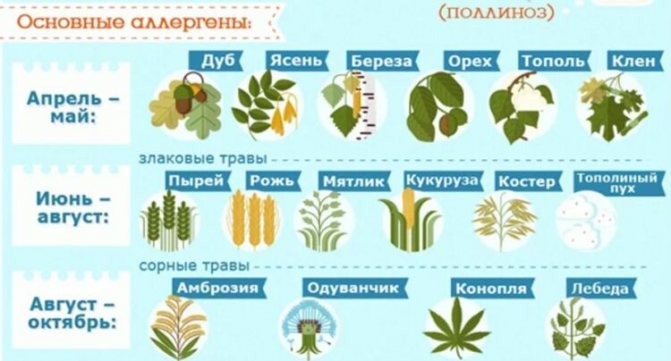
- For dandelion pollen. Pollen particles enter the respiratory tract and cause severe irritation. This happens quite quickly. Within a couple of hours, the respiratory system is affected;
- On tree pollen. When trees bloom, unpleasant symptoms occur. An allergy sufferer has difficulty breathing, thereby worsening sleep and general condition. Birch pollen often becomes an irritant;
- For weed pollen. Negative manifestations spoil the lives of many, starting from the end of summer and can continue until winter. Symptoms most often begin when inhaling ragweed and wormwood pollen;
- For pollen. It appears in the spring-summer period, at the height of flowering. Signs of allergies are often observed in children. Not only street flowers cause problems, but also indoor plants. Provoking plants can be: azalea, geranium, fern, oleander, hydrangea, Kalanchoe, etc.;
- For pine pollen. The disease develops when ingested by nut and pine pollen. It is quite rare. Particles settle in the respiratory tract and mucous membranes, after which symptoms develop. It is necessary to spend less time in places with large concentrations of coniferous trees;
- They ate for pollen. A negative reaction can be observed in winter, during the New Year holidays, when live spruce trees appear in the house. More often diagnosed in children. Classic symptoms occur. To alleviate the condition, live spruce trees are replaced with artificial ones.
- For pollen of meadow grasses. This type is not very common, but it is extremely difficult to fight. Signs of allergies appear at certain times of the year. After contact with an allergen, a number of symptoms occur. May be for the following types of plants: cornflowers, camassia quamash, gaillardia spinosa, aquilegia adhesive, etc.
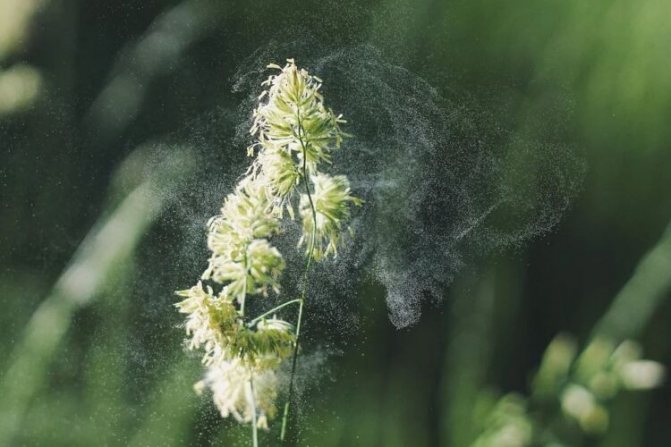
Prevention of hay fever
Diagnosis and treatment of flowering allergies produce results. But even under this condition, health is harmed. Preventive measures help reduce the risk of developing the disease. For example, it is important to carry out regular wet cleaning of premises. You should also minimize contact with the allergen if possible.
After being outside, it is recommended to wash your nose, eyes, and face. This will remove most of the pollen. During the period of active flowering, foods with a high allergic titer - chocolate, citrus fruits and others - are removed from the diet. Taking Magnesium B6 helps strengthen the nervous system. As is known, depression and anxiety also contribute to the development of the disease.
Prophylactic use of antihistamines also helps prevent allergies. Substances that block allergens accumulate in the body. But the products must be changed every 10 days.
Allergy to flowers, unfortunately, is not such a rare disease. It causes a lot of inconvenience and threatens the development of other chronic pathologies. With timely consultation with a doctor, correct diagnosis and correct treatment, it can be treated. Prevention also matters.
How to treat allergies in spring in adults and children
You can start treating the disease only after a thorough diagnosis. It is necessary to record all changes in the skin and how you feel. It is also important to identify the allergens that cause a negative reaction.
All data is taken into account throughout the entire flowering period of a particular plant. If symptoms are frequent, one can judge the presence of the disease.
Three generations of remedies are used to relieve symptoms and get rid of the disease. The most effective and safe medications are those from the last group.

First generation antihistamines:
Diphenhydramine has an anti-inflammatory effect. The active substance of the drug can cause anemia. Not allowed for use by children, pregnant and lactating women.
Tavegil is used for pseudoallergic reactions and anaphylactic shock. After taking it, activities that require increased attention are prohibited. Prescribed to children from one year of age, prohibited for pregnant women.
Diazolin is used for mild cases of the disease. It is not advisable to take the drug for pregnant women, breastfeeding, heart disease, prostate adenoma, epilepsy.
Second generation drugs:
Fenistil can be produced in different forms and can quickly relieve symptoms of the disease. You should be careful when using other medications together.
Trexil Neo is suitable for the treatment of chronic asthma. The dosage should be strictly controlled.
Gistalong is effective for 10 days and is a potent agent. Suitable for chronic illness. Do not take if you have pathology of the cardiovascular system.
Third generation drugs:
Cetrin is well tolerated by the body and does not cause drowsiness. To stabilize the condition, a single dose of the drug is recommended. Its analogues include: Zyrtec, Zodak, Cetirizine, etc.
Home flowers
We should also discuss house plants, which also quite often become the culprits of unwanted reactions in our body.
In general, a person suffering from an allergy to flowers is not recommended to keep indoor plants in the house.
For example, contact with American agave can result in the development of contact dermatitis. In this case, the person will not even suspect that the problem is in his favorite house plant. Here is a list of the most dangerous house flowers that may be potential pathogens:
- Geranium (during flowering, the smell of its essential oil causes unwanted reactions);
- Fern (reproduces by spores that spread throughout the room);
- Dieffenbachia (touching it by a person predisposed to allergies can result in a contact form of dermatitis);
- Eucharis and crinums (along with geranium, they emit essential oils that cause an allergic reaction).
- Azalea (during flowering, it fills the air with a persistent odor, which provokes unwanted reactions, including causing a rash on the body).
These are just some of the popular indoor plants that most people have in their homes. Contact with them should be avoided if a person is predisposed to allergic reactions.
How to get rid of allergies at home
Simple folk methods will help you cope with the disease. Often, acupuncture is used as treatment, a tincture of licorice root is taken, and a blood transfusion is also possible. It is important to complete the full course of treatment to achieve the best results.
Different stages of the disease will require different remedies. The drugs are prepared according to simple recipes and are quite effective in relieving the symptoms of the disease.
Mumiyo. 1 gram of product should be dissolved in one liter and mixed thoroughly. Take the composition 100 ml per day.
A decoction of the string. A tablespoon of raw material is poured into glasses of boiling water and boiled for 20 minutes over low heat. Strain the mixture and add water so that the glass is full. The healing composition is drunk throughout the day throughout the flowering period.
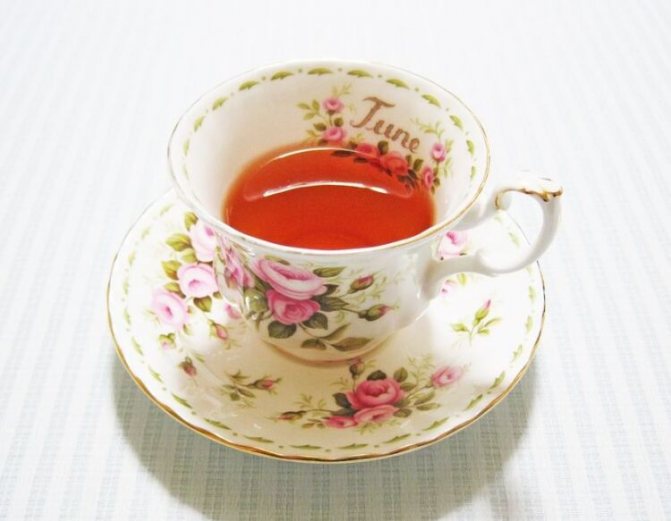
Garlic. Chop a few cloves, add three tablespoons of water and eat three times.
Apple-carrot juice. To prepare the composition, you need to squeeze the juice from two apples, two carrots, a bunch of parsley and two cauliflower inflorescences. Divide the resulting drink into three parts and drink before meals.
It is necessary to ensure that the diet includes pine nuts, figs, and cranberries. It is recommended to reduce the consumption of salty, spicy and fatty foods.
Rosehip and dandelion. You will need several rose hips and the same amount of dried dandelion roots. They are worth breaking. Pour one tablespoon of the mixture into a glass of boiling water. Pour the composition into a thermos and leave. Strain and consume before meals three times a day for three months.
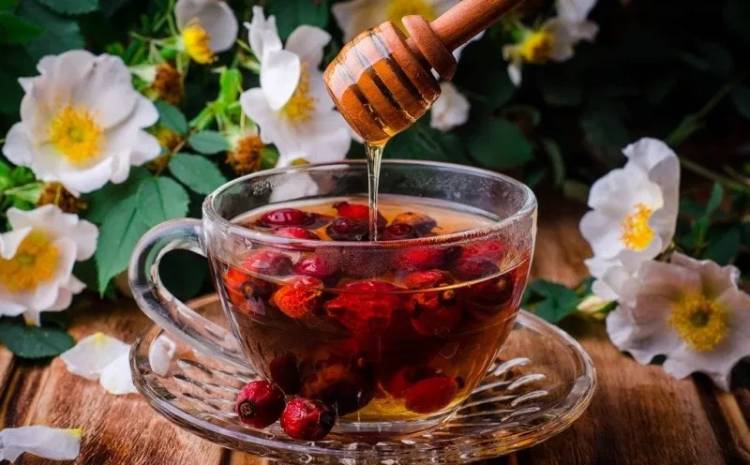
Breathing exercises

Breathing exercises
In the morning and evening, shortly before bed, do a set of simple exercises, which we give below. All exercises are performed standing with your back straight.
Exercise one . We stand straight, right hand on our stomach. Take a deep breath through your mouth, while trying to stick out your stomach as much as possible. Exhale through your nose, while trying to pull in your stomach.
Exercise two . Left hand on the chest, take a deep, slow breath. Exhalation is sharp, rapid.
Exercise three . Standing straight, slowly raise our arms up to the sides, palms up, and while we raise our arms, take a maximum breath. We also exhale slowly, lower our hands and place our right hand on our left shoulder and vice versa.
Exercise four . The beginning of the exercise is the same as in the third. As you exhale, we begin to turn the body to the right side, moving our right arm behind our back, and throwing our left arm over our right shoulder. We also turn our head as far as possible to the right. We repeat the same thing with a turn to the left.
Why does it happen?
Causes of allergies
There are several factors that can cause a person to develop seasonal allergies in the spring.
- One possible reason is hereditary. The risk of an allergic reaction to pollen and other irritants increases if the parents had this.
- Immunodeficiency increases the risk of developing an allergic reaction.
- If a person suffers from any chronic diseases, this increases the likelihood of spring allergies.
- Unacceptable environmental conditions for work and life.
During the allergy season, 700 species of plants and fungi serve as provocateurs.
"Allergies are harmless." “It is impossible to recover from it, which means treatment is useless”
These are two more myths that lead to the fact that many patients for years sneeze, breathe heavily or suffer from inflammation of the mucous membranes of the eight paranasal sinuses. In addition to rhinitis and sinusitis, inflammation of the middle ear (otitis media), the formation of polyps and cysts in the paranasal sinuses, and pollen bronchial asthma can occur.
Many potential patients of an allergist independently diagnose hay fever and take antiallergic, so-called antihistamines, drugs and sprays. Unfortunately, with their help you can only remove the symptoms, but not cure allergies.
The only method for treating allergies today is called allergen-specific immunotherapy (ASID). It allows you to get rid of the cause of the disease and achieve stable remission, when at the end of the treatment course the symptoms of hay fever will not recur. During the course of the program, slowly but systematically, instead of an allergic immune response, a normal one is formed.
Interesting Facts

Interesting Facts
- In the sixties of the last century, wheat grain contaminated with ragwort seeds was brought to the Krasnodar region. The grain was used for sowing. Ambrosia sprouted along with the wheat and during its flowering period caused a massive epidemic of hay fever.
- According to statistics, in the Amur region, up to ninety percent of the population suffers from an allergy to wormwood.
- In the Krasnodar Territory and Stavropol Territory there are more allergy sufferers to pollen of grasses and cereals, in central Russia - to pollen of flowering trees.
- It’s strange, but it’s a fact that in Moscow every third citizen is susceptible to seasonal allergies, in Berlin - the fourth, in New York - the sixth. And among rural residents, where, by definition, allergens simply teem in the air, those susceptible to allergies are significantly less likely.
- In Europe in the eighteenth century, there were only a few people suffering from hay fever. And these days, according to statistics, forty percent of the population with allergies lives among us. And, according to experts, every decade this figure doubles.
Preventive actions

Prevention
No source - no allergy, but this is not always possible, so read the rules of life if you have hay fever.
- If it's hot and windy outside, try to stay indoors. If possible, go outside in the afternoon. Rainy weather is great weather for walking under an umbrella. It’s raining from above, but it nailed all the harmful pollen to the ground and deprived it of the ability to fly.
- If you still can’t stay at home in sunny weather, be sure to wear dark glasses – they will at least somehow protect your eyes from pollen.
- Change your clothes every day, and wash the clothes you wore outside.
- Washed sushi items only at home. Of course, it’s better to dry it outside in the summer, but pollen will settle on your clothes.
- If there is no air conditioning installed at home and you have to constantly open the windows, cover them with nets and constantly make sure they are damp.
- You were invited to a picnic, you really want to go, but are you afraid of aggravation? Do not despair. You probably know which plant pollen is your enemy. Just find out if they grow in the place of the intended picnic? If not, feel free to go. If they grow, ask to change their resting place, if possible.




